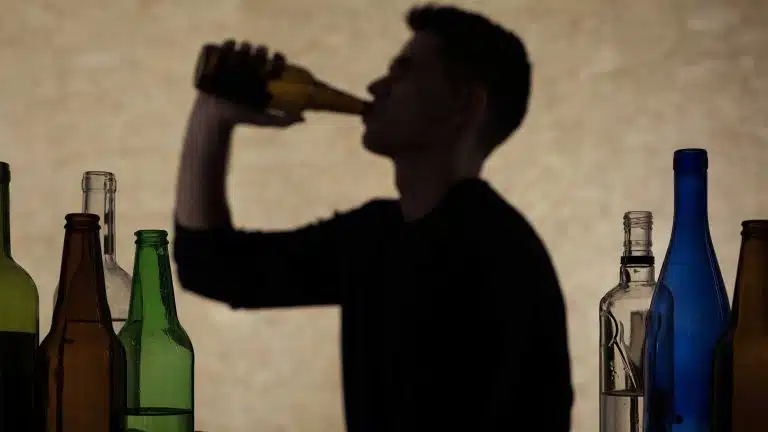What Is Heavy Episodic Drinking?
- Alcohol Consumption
- Prevalence
- Effects Of Heavy Episodic Drinking
- Risk Factors For Heavy Episodic Drinking
- Addressing Heavy Episodic Drinking

In short, heavy episodic drinking is the same thing as binge drinking. Both drinking events are defined by consuming large amounts of alcohol within two hours.
Classifying Alcohol Consumption
The Substance Abuse and Mental Health Services Administrations defines one standard drink as:
- 12 fl oz of beer (5% alcohol)
- 8-9 fl oz of malt liquor (7% alcohol)
- 5 fl oz of wine (12% alcohol)
- 1.5 fl oz of hard liquor (40% alcohol)
While definitions vary, heavy episodic drinking (a term favored by the World Health Organization) is generally considered synonymous with binge drinking (favored by American health organizations).
Binge drinking is defined as having five or more alcoholic beverages/standard drinks on a single occasion if male, or four or more drinks in a single occasion if female.
Binge Drinking Vs. Heavy Drinking
Binge drinking is different from heavy drinking (having fifteen or more drinks in one week if male, or 8 drinks or more in one week if female).
However, these two forms of high-risk drinking often occur in tandem, and may eventually contribute to the development of an alcohol use disorder (AUD), also known as alcohol dependence or alcoholism.
Extreme binge drinking, also known as high-intensity drinking, is generally defined as drinking two or more times the threshold for binge drinking, raising blood alcohol concentrations to far higher levels than is safe.
Heavy Episodic Drinking Prevalence
According to the CDC, binge drinking is a major threat to public health. Around 16% of United States adults binge drink around four times per month, consuming about seven alcoholic drinks on average each time.
Underage Drinking & Young Adults
Binge drinking is an especially common drinking behavior for young adults, including those who are underage. The majority of young drinkers (21 and younger) report binge drinking and heavy use of alcohol as their primary drinking habits.
Interestingly, while the majority of binge drinkers are 35 years old or younger, those in older demographics consume the majority of all binge drinks.
Income Levels
The same is true of income levels, as most binge drinkers are in the middle class and above, while those with household income lower than $75,000 consume a disproportionate majority of binge drinks.
Gender
In regards to gender, binge drinkers are twice as likely to be men as women, with men consuming around 80% of all binge drinks.
Effects Of Heavy Episodic Drinking
Binge drinking is associated with a variety of short and long-term effects. It is especially harmful for pregnant women, as alcohol consumption is known to cause miscarriage, birth defects, and fetal alcohol spectrum disorder (FASD).
Short-Term Effects
Potential short-term effects of heavy episodic/binge drinking may include:
- impaired coordination and reaction time
- impaired judgement and thinking
- dehydration
- sedation
- depressed mood
- hostility
- low blood pressure
- alcohol poisoning, which can be fatal
- increased likelihood of injury due to high-risk behavior
Long-Term Effects
Long-term effects of regular binge drinking include:
- weight gain
- high blood pressure
- insomnia
- social difficulties
- anxiety and depression
- cognitive problems
- immune system dysfunction
- heart disease
- liver disease
- stroke
- increased cancer risk
- increased risk of developing an AUD
Alcohol-Related Deaths
In addition, health care professionals blame more than half of all yearly alcohol-related deaths (approximately 95,000 individuals in the USA) on binge drinking, with deaths occurring due to alcohol poisoning, accidents, and other related causes.
Risk Factors For Heavy Episodic Drinking
Common risk factors for heavy episodic drinking include:
- age group, with those in their late teens and early twenties at highest risk
- personality, with traits like impulsivity, risk-taking, and sensation-seeking as common predictors for substance use
- genetics, often revealed by a family history of alcohol or drug use
- childhood factors, especially traumatic experiences, quality of parental involvement, and parental drinking habits
- environment, as college students tend to drink more when binge drinking, though non-college students tend to binge drink just as often as college students
- mental health, as stress, anxiety disorders, depression, and mental illness heavily correlate with drug and alcohol related-problems
Addressing Heavy Episodic Drinking
Despite the risks and harm involved, most binge drinkers never develop an alcohol use disorder (AUD) or alcohol dependence. However, binge drinking does put individuals at a much higher risk of becoming physically or psychologically dependent on alcohol over time.
A number of public health departments are actively working to curb binge drinking. Anyone concerned that their drinking habits are developing into an AUD are advised to follow-up with their health care provider and, if necessary, seek substance abuse treatment.
If you or a loved one are concerned about heavy, chronic, or compulsive problem drinking, we invite you to talk to an Ark Behavioral Health representative today to see if our treatment programs are the right fit for you.
Written by Ark Behavioral Health Editorial Team
©2024 Ark National Holdings, LLC. | All Rights Reserved.
This page does not provide medical advice.
Centers For Disease Control and Prevention - Binge Drinking
National Institute on Alcohol Abuse and Alcoholism (NIAAA) - Drinking Patterns and Their Definitions
Substance Abuse and Mental Health Services Administration (SAMHSA) - Alcohol Use Facts and Resources

Questions About Treatment?
Ark Behavioral Health offers 100% confidential substance abuse assessment and treatment placement tailored to your individual needs. Achieve long-term recovery.
100% confidential. We respect your privacy.
Prefer Texting?
Our friendly support team is here to chat 24/7. Opt out any time.







 Learn More
Learn More








